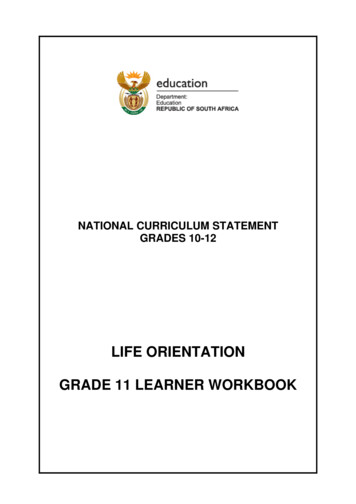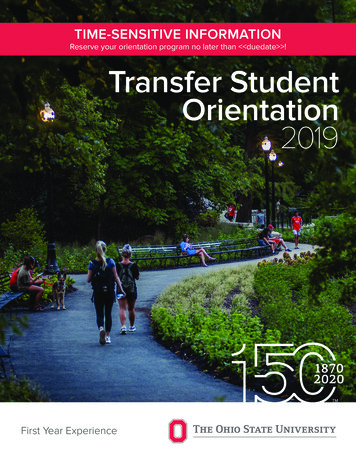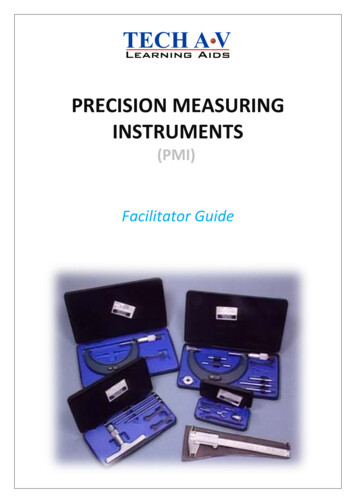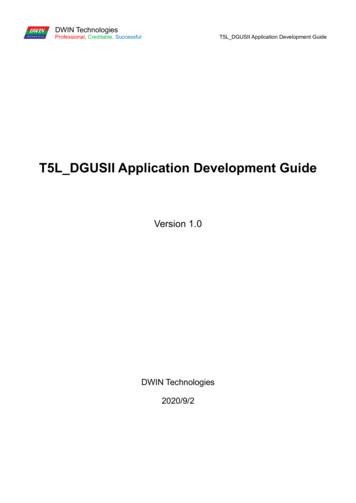
Transcription
NATIONAL CURRICULUM STATEMENTGRADES 10-12LIFE ORIENTATIONGRADE 11 LEARNER WORKBOOK
Grade 11 Learner Workbook: Life OrientationThis Learner Workbook should be used in conjunction with the Grade 11 TeacherGuide for Life Orientation which has been developed by the Department of Education.Department of EducationSol Plaatje House123 Schoeman StreetPrivate Bag X895Pretoria 0001South AfricaTel: 27 12 312-5911Fax: 27 12 321-6770120 Plein StreetPrivate Bag X9023Cape Town 8000South AfricaTel: 27 21 465-1701Fax: 27 21 461-8110http://education.gov.za 2007 Department of Education
TABLE OF CONTENTSPageTEXTSThe importance of planning.1Fitness requirements and components .4Goal setting the ‘SMART’ way .5Setting personal fitness goals .7Career options .11Tax deductions.14Compilation of a study plan.16The 5 food groups.19Energy expenditure during physical exercise.20Nutrition and exercise diary.21Decision-making .23Individual situations.24Values and personal decisions .25Constitutional values.27The value of religion in life .29Marriage and religion .30Ethical behaviour .35Workplace scenarios.36The balancing act.37Risk behaviour IQ .39Stop to think.40Accessing support, advice and assistance.41Moral issues and dilemmas.43How to reduce risk behaviours.44Violations of human rights.49Violations of environmental rights .51How to protect human dignity.52Organisations that deal with human rights .54Bullying is brutal.56Fighting for a cause .57Social activism .58Community service .59Democratic constitution making .60Democracy in action .62Choosing a career.63What helps get the job .66Job advertisements.68PHYSICAL EDUCATIONAssessment of personal fitness.70Planning and presentation of movement activities .72
TEXTSTHE IMPORTANCE OF PLANNINGTEXT A: Sound the alarmType 2 diabetes is becoming a threat as urbanlifestyles, especially, get worse.significant threats for the economic landscape ofcountries.Whether you blame it on sedentary lifestyle orsimply plead ignorance, diabetes 2 is on the rise.Diabetes prevalence is rife in developing countries.Unless there are serious interventions andawareness campaigns, world prevalence willdouble by 2030, says the World HealthOrganisation (WHO).“Undiagnosed and inappropriately treated diabetesleads to considerable ill-health, which not onlyaffectsworkplaceproductivitythroughabsenteeism and ill-health retirement, but has asignificant effect on corporate healthcare anddisability costs,” says Medscheme’s Dr DerrickBurns.Type 2 diabetes (also known as adult-onset) ispreventable. Obesity and bad lifestyle are the keydrivers of Type 2 diabetes. This, says Dr SeloacoeThooe, is why this type remains common in urbanareas.What is Type 2 diabetes and what areits causes?It is a lifestyle-related chronic disease that occurswhen the pancreas cannot produce sufficientinsulin or when the body does not use insulinproperly. Insulin is a hormone produced by thepancreas that helps control the amount of glucosein your blood. People older than 45 are at greaterrisk. Causes include being overweight, bad dietand physical inactivity.He bemoans the shortage of awarenesscampaigns and urges people to watch theirlifestyle and that of their children. WHOrecommends a body mass index of 30. One in 20South Africans is diabetic (2,4 million in total).What are the symptoms? Prof. Paul Rheeder notes that the increase in theepidemic is correlated to a rise in global obesity.On obesity, Rheeder reveals shocking statistics:29,2% of South African men are overweight orobese, compared to a staggering 56,6% of women. Dry mouth and increased thirst.Unexplained fatigue, weight loss andincreased appetite.Blurry vision and numbness in the hands andfeet.How to prevent it? “As urbanites, we have hectic lifestyles and we’regetting lazy. A typical trend is to get up, go to workwhere you’re more likely to use a lift (than stairs),come home, eat (junk food), sleep and the nextday it’s the same story,” says Dr Gladys Koete. Though experts agree that the key to avoid Type 2diabetes and other lifestyle diseases is a healthydiet (vegetables and moderate meat), exercisingand screening for blood glucose, at least once ayear, is vital.Be physically active: at least 30 minutes ofregular activity. Walk whenever possible.Detoxify regularly.Whenever visiting a doctor, ask for a urine,weight and blood pressure checks, for vitalsigns.Avoid high cholesterol and unhealthy foods.Where can I get help?Diabetes SA: (011) 792-9888 or (031) 205-8109Diabetic Helpline: 0860-102-672SOURCE: Shoks Mzolo, Sound the alarm,Financial Mail, September 28 (2007)In the same way that HIV and TB are renderingworkforces moribund, WHO says diabetes poses1
TEXT B: Youth unemployment ratesYouth Unemployment rates between 2001 and 2006Unemployment 5-24 yrs53.455.955.351.751.450.225-34 .8539.35Year15‐24 yrs25‐34 yrsAverage(Adapted from the Labour Force Survey, September 2006, published by Statistics South Africa)TEXT C: School drop-out ratesEnrolment at education institutions drops rapidly after age sixteen, as shown in the figure below.Rate of attendance per age groupFigure: Rate of education institution attendance among the 15-24 year 62.927.2Student/learner age in yearsSep-02Sep-03Sep-04Sep-05(Adapted from General Household Survey, 2006 published by Statistics South Africa)2Sep-06
TEXT D: Reasons for not attending an education institutionLack of money to finance education of the 7-24 year-olds remains the strongest impediment to access toeducation and training. From 2003 to 2008, the percentage of the 7-24 year-olds prevented by lack money toaccess education has consistently remained between 37 and 38%.Lack of moneyWorkingExam failureIllnessMarriageYear 200338.515.34.93.41.9Year 200437.19.96.54.82.1Year 200537.418.46.63.91.0Year 200638.815.85.54.21.2TEXT E: Promotion Requirements for the National Senior Certificate7 National Curriculum Statement SUBJECTSMINIMUM REQUIREMENTS FOR PROMOTION ANDCERTIFICATION4 COMPULSORY SUBJECTS 2 Languages (one Language at Home Languageand other Language at least at First Additional levelor home language level) One of these languagesshould be the language of learning and teaching(LoLT) A learner must achieve 40% in three subjects, one ofwhich is an official language at Home Language level, andMathematics OR Mathematical Literacy30% in three subjects. Life Orientation3 CHOICE SUBJECTS Any 3 other National Curriculum Statement subjects(including official and non-official languages atQUESTIONS What do the texts tell you about planning?Why must one plan?How seriously have you been planning for the different areas in your life: career, health, further study,etc.?What aspect of your life do you need to do more planning for?3
FITNESS REQUIREMENTS AND COMPONENTSA. THE FIVE HEALTH-RELATED COMPONENTS OF FITNESSBody Mass Index (BMI): Level of under- or over-nutrition compared to ideal weight range. BMI (Body Mass Index) isa measure used by doctors to determine the best weight range for a person’s health. It is an approximate measureof total body fat. It is calculated using a person’s height and weight in the following formula: weight in kg divided byheight in m squared (weight (kg) / height (m)2 ). A BMI measure of 20-25 is considered healthy.Cardiovascular fitness: Ability of the heart to provide the muscles with oxygen during sustained exerciseFlexibility: Range of motion available in the different jointsMuscular endurance: Ability of the muscles to work over a sustained period of timeMuscular strength: Ability to exert force or lift heavy weights B. F.I.T.T. (FREQUENCY, INTENSITY, TIME, AND TYPE) PRINCIPLESFrequency: 3–5 times/week – daily warm-up, cool-downIntensity: exercise at a higher-than-normal level, e.g. 60–90% of age mediated maximum heart rate; the number ofrepetitions of a movement and the number of sets repeated can impact on intensityTime: 20–60 minutes of continuous activityType: progressive; large muscle groups; continuous e.g. rhythmic running, cycling, swimming C.TRAINING HEART RATE ZONEIf cardiovascular endurance is to be developed, one must exercise regularly in the fitness target zone. The intensity ofthe exercise must therefore elevate the heart rate above 60% of its working range during the exertion phase. Anindividual must exercise within their own training heart rate zone.How to calculate training heart rate zone:1. Start with the number 220 and subtract your age in years to arrive at your maximal heart rate:220 – Age Maximal heart rate2. Take your maximal heart rate and subtract your resting heart rate to arrive at your working heart rate:Maximal heart rate – Resting heart rate Working heart rate3. Now calculate your training heart rate zone (i.e. 60% threshold and 80% upper level) as indicated in the tablebelow.NOTE: Resting pulse/ heart rate is the rate at which your heart is beating per minute once you have been lying in arelaxed and reclined position for approximately 2 minutes.60% threshold levelStart with your working heart rate Multiply by .60x .60Get a subtotal Add your resting pulse This answer is your threshold trainingheart rate at 60% effort levelWhat is your training heart rate zone? 80% upper levelStart with your working heart rateMultiply by .80Get a subtotalAdd your resting pulseThis answer is your trainingheart rate at 80% effort levelto beats per minute4 x .80
GOAL SETTING THE ‘SMART’ WAYTo be effective, goals should be Specific, Measurable, Attainable, Realistic and implemented in a Time frame,i.e. SMART.SPECIFIC: Are they clearly stated? Goals are personal – other people cannot set goals for you. Identify the goals – identifying what you want to achieve is essential before you can start setting goals. Wanting to make a change and doing it are two different things; identify the target(s). Clarify exactly what it is that you want to accomplish or be able to do. Each goal should contain thefollowing 4 essential elements:o What you are going to accomplish – state the goal(s) and describe the indicators that will tell youwhen you have achieved the goal(s).o How you are going to accomplish it – break each goal up into separate action steps that will helpyou achieve the goal.o When you are going to accomplish it – indicate time frames for the completion of each action andthe achievement of the goal itself.o Where you are going to accomplish it.MEASURABLE: How will you know when you have achieved the goals? Goals need to be progressive – a series of progressive or small steps – so you know whether there hasbeen a change. Analyse where you are now to help you determine what you need to do to achieve your goals so you canmeasure to see your progress – e.g. increase exercise time from 10 minutes to 30 minutes a session.ATTAINABLE: Is it possible for you to achieve the goals? Must be a goal that can be accomplished and is within your abilities and control. Must be personally owned and not imposed by others.REALISTIC: Is it probable or likely that you will achieve the goals? A realistic goal is one that can be reached. If you believe you can do something, you have a better chance of accomplishing it. Goals must not be too easy or you lose interest in them. Goals must not be too hard or you become discouraged and give up.TIMEBOUND: By when will the goals be achieved? Set a date by which each goal will be achieved. Establish a time frame to complete each of the actions that you will perform to achieve each of your goals. The use of timelines gives a sense of organization and control, promotes commitment to the goal andhelps pace your efforts.INSTRUCTIONSList examples of short-, medium and long-term goals in your own life. Identify 2-3 short-term goals that can beaddressed within a month. One of these should be health-related. Use the SMART approach to goal setting todevelop an action plan to achieve these goals. A planning template is provided on page 6.5
ACTION PLAN TEMPLATEGoalsActions to be takenAchievement indicatorsDate / Time frameProgressReflectionDescribe what the 2-3 shortterm goals areList the actions to be taken inachieving each of the goalsrespectivelyList the signs/ products thatwill indicate that you haveachieved each of the goalsrespectivelyAllocate a date of completion/time frame for each of theactions per goalAfter taking the actions toachieve the goal, reflect onhow well each wasimplemented – highlight bothsuccesses and failures whererelevantList the factors that made itpossible and/or difficult toachieve the goal AND whatyou still need to do to achievethe goals if they have not beenrealised in the stipulated timeframe6
SETTING PERSONAL FITNESS GOALSA.HEALTH-RELATED FITNESS NORMSCOMPONENTBody Mass Index (BMI)Flexibility:SIT AND REACH TESTMuscular Endurance:SITTING TUCKSMuscular Strength:STANDING LONGJUMPCardiovascularEndurance:STEP TESTCardiovascularEndurance:12-MINUTE RUNB.ZoneUnderweight:Healthy:Overweight:Obese:High performance:Good fitness:Marginal:Low:High performance:Good fitness:Marginal:Low:High performance:Good fitness:Marginal:Low:High performance:Good fitness:Marginal:Low:High performance:Good fitness:Marginal:Low:NORMS (17-26 years of age)under 2020 - 2525 - 30Over 30Male: more than 35cmFemale: more than 38cmMale: 25 - 35cmFemale: 25 - 38cmMale: 15 - 24,5cmFemale: 15 - 24,5cmMale: less than 15cmFemale: less than 15cmMale: more than 34Female: more than 24Male: 20 - 34Female: 20 - 24Male: 15 - 19Female: 10 - 19Male: less than 15Female: less than 10Male: further than body lengthFemale: further than ¾ of body lengthMale: ¾ of body lengthFemale: 2/3 of body lengthMale: ½ of body lengthFemale: ½ of body lengthMale: less than ½ of body lengthFemale: less than ½ of body length84 or less85 - 9596 - 119120 and aboveMale: 3,1 km or moreFemale: 2,5 km or moreMale: 2,6 - 3,0kmFemale: 2,1 - 2,4kmMale: 2,3 - 2,5kmFemale: 1,9 - 2,0kmMale: less than 2,3kmFemale: less than 1,9kmTEMPLATE FOR RECORDING FITNESS RATINGRate performance in each of the health-related components of physical fitness against the norms that were provided by the teacher.Use an O for existing performance. Indicate what your ideal is for each component with an X:COMPONENT1(Low)2341. Cardiovascular endurance2. Muscular Strength3. Body Mass Index4. Flexibility5. Muscular Endurance7RATING5678910(High)
C.PERSONAL FITNESS PLANUse the SMART principles of goal setting in the compilation of your personal fitness plan: SPECIFIC (is it clear?)MEASURABLE (how will you know when you get there?)ATTAINABLE (is it possible?)REALISTIC (is it probable?)TIMEBOUND (what are the timelines for completion?)The plan should include the following:1. My five health-related fitness goals – state each of these individually2. Actions, timeframes and evidence – state the types of physical activity you are going to engage in andthe duration and frequency of your participation for:a. Tomorrowb. The next weekc. The next monthHow will I know I have been successful in achieving my goal? How will I reward myself?What challenges or barriers might prevent me from meeting my goals?What actions or steps could I take to overcome these challenges?3. An exercise logbook – see the instruction and template provided on page 9.4. A monthly tracking sheet - see the instruction and template provided on page 10.8
Exercise Logbook: Record the following table in your exercise book to help you keep track of your participation in physical activities as part of your personal fitnessplan.Date25/02/2007Heart Rate per minuteRHR 92EHR 142ActivityDuration45 minutesAerobicsRHR resting heart rate; EHR exercise heart rate9CommentFelt good – muscles a little stiff
Monthly tracking sheet: Record the following table in your work book to help you keep track of your progress in the five health-related components of fitness. Youshould use the same fitness tests as used to assess your level of fitness to track your progress once a month.DateJanuaryCardiovascular enduranceMuscular StrengthMuscular berOctoberNovemberDecember10FlexibilityBody Mass Index
CAREER OPTIONSThere are so many careers for young people to choose from today that it is often difficult to make a finalchoice. In some instances, people end up making the wrong choice and in other instances people land updoing something totally different to what they originally expected or intended. The interviews provided belowwere conducted with people from a variety of careers.FASHION DESIGNERVanya Mangaliso (32) is a co-founder with her husband, Thando, of Sun Goddess, a fashion design business with stores in TheZone in Rosebank, Joburg, Gateway in Durban and the V&A Waterfront in Cape Town. She matriculated at Vaal High School inVanderbijlpark in Gauteng before completing a social science degree and a one-year postgraduate diploma in organization andmanagement, both at the University of Cape Town.WHY DID YOU STUDY SOCIAL SCIENCE?When I was younger, I wanted to become a doctor, then a pharmacist, but then decided to go into finance. I did social science so Icould do my own combination of subjects.HOW DID YOU END UP IN FASHION DESIGN?I worked in marketing and advertising and decided I wanted to do something with fashion and imaging. Also, the kind of clothes Iwanted were not available.DID YOU THEN STUDY DESIGN?No, it’s just been a passion from the early days.DO YOUR UNIVERSITY STUDIES HELP YOU IN DESIGNING AND RUNNING SUN GODDESS?Definitely. You need a balance between designing and business sense.RESTAURANT OWNERUlla Pakendorf Loubser (33) works as a chef. She owns her own restaurant, Ullala, in Randburg, Gauteng. She received formaltraining at the private Institute of Culinary Arts near Stellenbosch in the Western Cape. Her first job, however, was as a newspaperjournalist. Thereafter she started a small arts and crafts business before going into the food business. She has a BA degree from theformer Potchefstroom University (now North-West University) and an Honours degree in philosophy obtained from the University ofSouth Africa (UNISA).WHAT DID YOU WANT TO BE WHEN YOU WERE 15, AND WHY?A journalist. My father and mother were both journalists.WHAT INFLUENCED YOU TO DO WHAT YOU ARE DOING NOW?I enjoyed cooking for the whole family every night of the week and every week of the year, but I wanted formal knowledge of cooking.My university education did give me a thorough grounding to tackle the theory of food creation, like how the concept of a chefdeveloped. Even my philosophy education helped. You need to know what Nietzsche said before you can differ with him! You needto know how to make a basic sauce before you can experiment.WHY DID YOU GO TO UNIVERSITY?When I left school, society expected you to go to university. The mindset at that time was that you had to go to university to find ajob.WHY DID YOU STUDY PHILOSOPHY?Philosophy is amazing. It teaches you logic. It shows you that everything is possible and believable – as long as you can explain itlogically. I even apply it as a chef. I have to believe that if I prepare my food well, it will sell well.WHAT IS THE MOST IMPORTANT THING THAT YOU LEARNED AT UNIVERSITY?It taught me to think, which branched into my philosophy studies. When you are at university, you come across so many new thingsand new questions, and each answer leads to another question.11
BIOCHEMISTDr Debra Meyer (30) is a biochemist at the University of Johannesburg. With her research she hopes to help develop avaccine for HIV. Meyer is also an Aids activist. She gives talks in communities, aimed at slowing down the spread of HIV.She obtained a BSc, an Honours degree and a Master's degree at the former Rand Afrikaans University (RAU), now theUniversity of Johannesburg. She completed a PhD at the University of California in the United States. She was the firstwomen and only black lecturer in the Faculty of Science when she was appointed at RAU in 1997. Meyer is also afamiliar face on TV; she presents the weather forecast in Afrikaans on SABC2.WHAT DID YOU WANT TO BE WHEN YOU WERE 15, AND WHY?The answer is simple. All I wanted to be when I was 15 was educated. I had this idea that educated people could getanything they wanted.WHAT INFLUENCED YOU TO DO WHAT YOU ARE DOING NOW?I read a lot. I started to find out about careers. The one career that particularly attracted my attention was being amicrobiologist. I read about people studying small organisms, invisible things that can cause so much disease that theycan destroy the strongest of human beings. I was fascinated, but frustrated because nobody in my community could tellme how to become a microbiologist.HOW DID YOU KNOW WHICH SUBJECTS TO CHOOSE?I was reading a lot of books, so I discovered that I needed biology and natural science. Choosing the rest of the subjectswas easy; the languages were compulsory and the programmes were designed in such a way that if you chose scienceyou had to do maths. The only additional subject I did was accounting. I wanted to keep my options open in case Iwanted to do other things – for example, going into business.DID ANYONE HELP YOU TO MAKE DECISIONS ABOUT YOUR SUBJECTS?No one helped me to make choices. I did it by myself. The teachers did not have all the information either. Their advicewas to choose what you are good at and what you enjoy, but they could not tell me that if I wanted to be a microbiologistI had to do a certain set of subjects.WHY DID YOU GO TO UNIVERSITY?When I decided at 15 to be educated, I decided I would go to university because that is where you get the besteducation. For the type of career I wanted I definitely had to go to university.WHAT IS THE MOST IMPORTANT THING THAT YOU LEARNED WHILE STUDYING?What was extremely important to me was not just my academic training, but learning about life, about being tolerant andrealising everyone is not the same and they don’t have to be. I expected to learn chemistry and biochemistry. I did notexpect I would find out how to deal with different cultures a bit better.TV ACTORElma Postma is “Dezi” from 7de laan. The 26-year-old grew up in Klerksdorp in North-West province, where shematriculated from Hoërskool Wesvalia. Postma has a drama degree from the University of Pretoria. She has worked as aresidential actor for the civic theatre in Witbank in Mpumalanga, where she was in everything from cabaret to drama.She also earned money as a waitron and worked as a marketer before she became “Dezi”.WHAT DID YOU WANT TO BE WHEN YOU WERE 15, AND WHY?I think I wanted to be a doctor or something in a medical field. I thought I would earn more money and because mybrother was studying medicine.WHEN DID YOU DECIDE TO STUDY AFTER SCHOOL?In my matric year around October I decided on drama after I had plans to study occupational therapy. These two fields ofstudy have very little in common, but I am happy about my final choice.CAN YOU REMEMBER WHAT IT WAS LIKE TO MAKE DECISIONS ABOUT YOUR FUTURE?Difficult! There is uncertainty because you are afraid that you are making the wrong choice. What if you don’t like it, or ifyou can’t find a job, and so on? People can give you advice, but in the end you have to make the decision. Do you reallywant to do something that other people chose for you? My parents and teachers encouraged me, but I made the finaldecision on my own.12
TEACHERPoovanthran Chetty (33) is a physical science teacher at Nigel Secondary on the East Rand of Gauteng. In fact, he is the head of theschool’s department of physical science, mathematics and computer subjects. He has been teaching for eight years, after completinghis BSc degree at the former University of Natal, which is now part of the University of KwaZulu-Natal. He also has an Honoursdegree and is currently enrolled for a Master’s degree at the University of Johannesburg. Chetty was part of a handpicked group of39 South African mathematics and science teachers who went on a two and a half month study tour to the United States recently.WHAT DID YOU WANT TO BE WHEN YOU WERE 15, AND WHY?A pharmacist. Chemicals fascinated me from a very young age.WHEN SHOULD WE START TO THINK ABOUT THE FUTURE?At the end of Grade 9, but the final decision should be at the end of Grade 11. The way in which you pass your subjects should tellyou what career path to choose.WHAT INFLUENCED YOU TO DO WHAT YOU ARE DOING NOW – TEACHING?I had to decide in the third year of my first degree whether I wanted to pursue engineering or pharmacy. But I come from aneducation background. My father is a retired school principal and I have four sisters – three of them work in the education field.ENTREPRENEURZama Ngubane (27) owns her own health spa. This young entrepreneur is a pioneer, because the health and beauty industry onlyrecently started to cater for black beauty and health care. After Ngubane finished school she enrolled for a B Comm. degree at Wits.She did not finish, but the experience helped her realise she wanted to do something more practical. She completed a qualificationin skin and body therapy. Instead of immediately finding a job in the beauty industry, she first worke
3. Now calculate your training heart rate zone (i.e. 60% threshold and 80% upper level) as indicated in the table below. NOTE: Resting pulse/ heart rate is the rate at which your heart is beating per minute once you have been lying in a relaxed and reclined position for app











